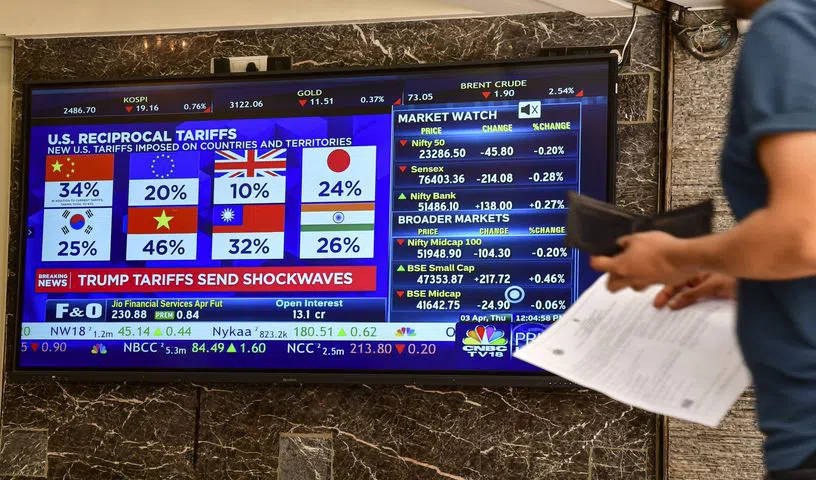
The White House fact sheet, read by Trump says India’s uniquely burdensome and duplicative testing and certification requirements in sectors such as chemicals, telecom products, and medical devices make it difficult or costly for American companies to sell their products in India
New York: India imposes its “own uniquely burdensome” testing and certification requirements in sectors such as chemicals, telecom products, and medical devices, making it “difficult or costly” for American companies to sell their products in the country, the White House said.
In a fact sheet issued after US President Donald Trump announced sweeping reciprocal tariffs on countries that levy taxes on US goods, the White House stated that non-tariff barriers — meant to limit the quantity of imports/exports and protect domestic industries — also deprive US manufacturers of reciprocal access to markets around the world.
Citing the example of India, the White House fact sheet said: “India imposes its own uniquely burdensome and/or duplicative testing and certification requirements in sectors such as chemicals, telecom products, and medical devices that make it difficult or costly for American companies to sell their products in India. If these barriers were removed, it is estimated that US exports would increase by at least US$ 5.3 billion annually.”
Trump announced a 26 per cent “discounted reciprocal tariff” on India, half of the 52 per cent levies imposed by the country on American goods, as he described India as “very, very tough.”
The fact sheet, titled ‘President Donald J Trump Declares National Emergency to Increase our Competitive Edge, Protect our Sovereignty, and Strengthen our National and Economic Security’, noted that Trump has declared that foreign trade and economic practices have created a national emergency, and his order imposes responsive tariffs to strengthen the international economic position of the United States and protect American workers.
On the issue of addressing trade imbalances, the White House said that Trump is working to level the playing field for American businesses and workers by confronting the unfair tariff disparities and non-tariff barriers imposed by other countries.
“For generations, countries have taken advantage of the United States, tariffing us at higher rates,” it said, citing the example that the United States imposes a 2.5 per cent tariff on passenger vehicle imports (with internal combustion engines), while the European Union (10 per cent) and India (70 per cent) impose much higher duties on the same product. For networking switches and routers, the United States imposes a 0 per cent tariff, but India (10-20 per cent) levies higher rates. For rice in the husk, the US imposes a tariff of 2.7 per cent, while India (80 per cent), Malaysia (40 per cent), and Turkey (31 per cent) impose higher rates. Apples enter the United States duty-free, but not so in Turkey (60.3 per cent) and India (50 per cent).
“The United States has one of the lowest simple average most-favoured-nation (MFN) tariff rates in the world at 3.3 per cent, while many of our key trading partners, like Brazil (11.2 per cent), China (7.5 per cent), the European Union (5 per cent), India (17 per cent), and Vietnam (9.4 per cent), have simple average MFN tariff rates that are significantly higher,” the White House fact sheet said.
The White House stated in the fact sheet that China’s non-market policies and practices have given China global dominance in key manufacturing industries, decimating US industry.
As he announced the tariffs from the Rose Garden in the White House, Trump held up a chart showing the tariffs that countries such as India, China, the European Union, Japan, Taiwan, South Korea, Bangladesh, Sri Lanka, and Pakistan levy on US products and the reciprocal levies that these countries will now have to pay.
On India, the chart showed that the country charged 52 per cent tariffs on the US “including currency manipulation and trade barriers,” and America will now charge India “discounted reciprocal tariffs” of 26 per cent.
“India, very, very tough. Very, very tough. The Prime Minister just left. He’s a great friend of mine, but I said, ‘You’re a friend of mine, but you’re not treating us right.’ They charge us 52 per cent. You have to understand, we charge them almost nothing, for years and years and decades, and it was only seven years ago, when I came in, that we started with China and we took in hundreds of billions of dollars from China in tariffs,” Trump said.
Describing April 2, 2025 as “Liberation Day,” Trump announced reciprocal tariffs of varying degrees on 185 nations.
Trump listed various countries from around the world and the tariffs they charge on US products.
Joined by factory and automotive workers as well as members of his Cabinet in the audience, Trump signed the “historic Executive Order” instituting reciprocal tariffs on countries throughout the world.
“Reciprocal. That means they do it to us and we do it to them. Very simple. Can’t get any simpler than that,” Trump said to applause from those gathered for the event.







